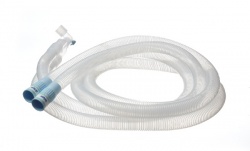How hospitals profit from tiny transponders
An RFID transponder (also known as a tag) consists of a chip and tiny antenna. Thanks to their small size these transponders can be integrated into almost any object, including clothing, boxes or even sheets of paper. Thus the logistics industry numbers amongst the prolific areas of application for wireless frequency identification using RFID (radio frequency identification) technology.


RFID systems simplify the identification, tracking and storage of goods and products. Furthermore, the radio technology is used in toll systems and for access control; it has also been used in the field of medicine in recent years. The technology, for example, allows medical devices and accessories to communicate with each other and simplifies frequently recurring activities such as the connection of ventilation hoses in intensive care and the operating theatre.
RFID in daily clinical routine
Dräger is the first manufacturer to produce RFID technology for medical devices and accessories, and one of the first hospitals to use RFID in technical medical devices and mechanical accessories is Zurich University Hospital. The hospital equipped its surgical area and anaesthetic induction and recovery areas with Dräger’s anaesthetic devices with radio technology. Ventilation hoses equipped with radio chips, for example, can store the ventilation settings of a patient. These ventilation settings are transferred to the new device when switching to another RFID-capable anaesthetic device or intensive ventilator.
Without that tool, the ventilation settings must be entered again, every time a new device is used. The radio technology allows the information stored on the integrated radio chip at the end of the hose to be transmitted to the medical device. To do so, a reading module in the device sends an impulse to the chip in the hose and can then receive its stored data. A piece of software further processes the data and converts it into information that the user can understand.
Not only is the transmission of ventilation parameters between accessories and devices quickly and easily possible, but also, with the help of RFID systems, a certain accessory can be clearly assigned to a medical device. An RFID ventilation hose, for example, is provided with specific device recognition which significantly simplifies finding the suitable hose for the respective RFID-capable medical device.
The proper hose on the right nozzle
Another advantage: Frequency identification helps to place the ventilation hose on the right nozzle of the anaesthetic device. The inspiratory and expiratory port, as well as the connection for the ventilation hose, are all standardised for anaesthetic devices and have the same diameter. The connection thus requires increased attention. If an inspiratory ventilation hose is mistakenly connected to the port for the respiratory bag, changes in the ventilation parameters will alert the user about the mistake. However, with RFID technology the mistake will be indicated immediately, acoustically and optically.
RFID systems can also be used to monitor replacement intervals of accessory parts with limited lifetimes, such as water traps and CO2 absorber, more simply. In the past the standard procedure was to monitor the timely replacement of accessory parts of an anaesthetic or ventilation device manually, with the help of lists and stickers. However, with RFID the date of the first use is stored on the radio chip and the need for replacement is automatically communicated on the device screen upon the expiration of a preset deadline, e.g. 28 days for a water trap.
Outlook
‘The RFID technology supports hospital personnel during routine work and simplifies tasks,’ Dräger reports. ‘We are, however, still at the beginning in terms of the use of RFID in medical technology. Alongside RFID-capable anaesthetic devices and intensive ventilators, Dräger has also been offering a ventilator specialised for neonatal ventilation with this technology since the beginning of the year: the Babylog VN500.’
As Andreas Otto, Senior Product Manager Lifecycle Solutions at Dräger, said: ‘Overall, the use and further development of frequency identification in medical technology offers a great deal of potential and is far from being completed.’
03.11.2010











